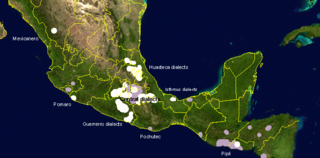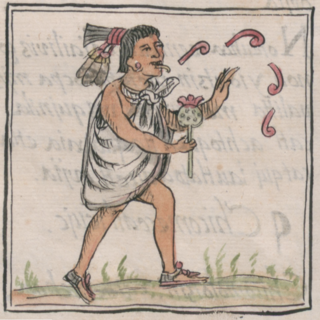Related Research Articles

Korean is the native language for about 80 million people, mostly of Korean descent. It is the official and national language of both North Korea and South Korea. The two countries have established standardized norms for Korean, and the differences between them are similar to those between Standard Chinese in mainland China and Taiwan, but political conflicts between the two countries have highlighted the differences between them. North Korea criminalizes the use of the South's standard language with the death penalty, and South Korean education and media often portray the North's language as alien and uncomfortable.

Language is a structured system of communication that consists of grammar and vocabulary. It is the primary means by which humans convey meaning, both in spoken and written forms, and may also be conveyed through sign languages. The vast majority of human languages have developed writing systems that allow for the recording and preservation of the sounds or signs of language. Human language is characterized by its cultural and historical diversity, with significant variations observed between cultures and across time. Human languages possess the properties of productivity and displacement, which enable the creation of an infinite number of sentences, and the ability to refer to objects, events, and ideas that are not immediately present in the discourse. The use of human language relies on social convention and is acquired through learning.
Sociolinguistics is the descriptive study of the effect of any or all aspects of society, including cultural norms, expectations, and context, on language and the ways it is used. It can overlap with the sociology of language, which focuses on the effect of language on society. Sociolinguistics overlaps considerably with pragmatics and is closely related to linguistic anthropology.
In linguistics, code-switching or language alternation occurs when a speaker alternates between two or more languages, or language varieties, in the context of a single conversation or situation. Code-switching is different from plurilingualism in that plurilingualism refers to the ability of an individual to use multiple languages, while code-switching is the act of using multiple languages together. Multilinguals sometimes use elements of multiple languages when conversing with each other. Thus, code-switching is the use of more than one linguistic variety in a manner consistent with the syntax and phonology of each variety. Code-switching may happen between sentences, sentence fragments, words, or individual morphemes. However, some linguists consider the borrowing of words or morphemes from another language to be different from other types of code-switching. Likewise, code-switching can occur when there is a change in the environment one is speaking. Code-switching can happen in the context of speaking a different language or switching the verbiage to match that of the audience. There are many ways in which code-switching is employed, such as when a speaker is unable to express themselves adequately in a single language or to signal an attitude towards something. Several theories have been developed to explain the reasoning behind code-switching from sociological and linguistic perspectives.

Mesoamerican languages are the languages indigenous to the Mesoamerican cultural area, which covers southern Mexico, all of Guatemala and Belize and parts of Honduras and El Salvador and Nicaragua. The area is characterized by extensive linguistic diversity containing several hundred different languages and seven major language families. Mesoamerica is also an area of high linguistic diffusion in that long-term interaction among speakers of different languages through several millennia has resulted in the convergence of certain linguistic traits across disparate language families. The Mesoamerican sprachbund is commonly referred to as the Mesoamerican Linguistic Area.
In semiotics, linguistics, anthropology, and philosophy of language, indexicality is the phenomenon of a sign pointing to some element in the context in which it occurs. A sign that signifies indexically is called an index or, in philosophy, an indexical.

Uto-Aztecan, Uto-Aztekan or Uto-Nahuatl is a family of indigenous languages of the Americas, consisting of over thirty languages. Uto-Aztecan languages are found almost entirely in the Western United States and Mexico. The name of the language family was created to show that it includes both the Ute language of Utah and the Nahuan languages of Mexico.

The Nahuan or Aztecan languages are those languages of the Uto-Aztecan language family that have undergone a sound change, known as Whorf's law, that changed an original *t to before *a. Subsequently, some Nahuan languages have changed this to or back to, but it can still be seen that the language went through a stage. The best known Nahuan language is Nahuatl. Nahuatl is spoken by about 1.7 million Nahua peoples.
The Japanese language makes use of a system of honorific speech, called keishō (敬称), which includes honorific suffixes and prefixes when referring to others in a conversation. Suffixes are often gender-specific at the end of names, while prefixes are attached to the beginning of many nouns. Honorific suffixes also indicated the speaker's level and referred an individual's relationship and are often used alongside other components of Japanese honorific speech.
Yavapai is an Upland Yuman language, spoken by Yavapai people in central and western Arizona. There are four dialects: Kwevkepaya, Wipukpaya, Tolkepaya, and Yavepe. Linguistic studies of the Kwevkepaya (Southern), Tolkepaya (Western), Wipukepa, and Yavepe (Prescott) dialects have been published.

Otomi is an Oto-Pamean language spoken by approximately 240,000 indigenous Otomi people in the central altiplano region of Mexico. Otomi consists of several closely related languages, many of which are not mutually intelligible. The word Hñähñu[hɲɑ̃hɲṹ] has been proposed as an endonym, but since it represents the usage of a single dialect, it has not gained wide currency. Linguists have classified the modern dialects into three dialect areas: the Northwestern dialects are spoken in Querétaro, Hidalgo and Guanajuato; the Southwestern dialects are spoken in the State of Mexico; and the Eastern dialects are spoken in the highlands of Veracruz, Puebla, and eastern Hidalgo and villages in Tlaxcala and Mexico states.
Tetelcingo Nahuatl, called Mösiehuali̱ by its speakers, is a Nahuatl variety of central Mexico. It is one of the core varieties closely related to Classical Nahuatl. It is spoken in the town of Tetelcingo, Morelos, and the adjacent Colonia Cuauhtémoc and Colonia Lázaro Cárdenas. These three population centers lie to the north of Cuautla, Morelos and have been largely absorbed into its urban area; as a result the Tetelcingo language and culture are under intense pressure.
Tetelcingo is a town in Cuautla, Morelos, Mexico. Located about 6 kilometers north of the city of Cuautla, Tetelcingo and the neighborhoods Colonia Cuauhtémoc and Colonia Lázaro Cárdenas are practically swallowed up in the urban area.
Proto-Nahuan is a hypothetical daughter language of the Proto-Uto-Aztecan language. It is the common ancestor from which the modern Nahuan languages have developed.
In linguistics, an honorific is a grammatical or morphosyntactic form that encodes the relative social status of the participants of the conversation. Distinct from honorific titles, linguistic honorifics convey formality FORM, social distance, politeness POL, humility HBL, deference, or respect through the choice of an alternate form such as an affix, clitic, grammatical case, change in person or number, or an entirely different lexical item. A key feature of an honorific system is that one can convey the same message in both honorific and familiar forms—i.e., it is possible to say something like "The soup is hot" in a way that confers honor or deference on one of the participants of the conversation.
Linguistics is the scientific study of language. The modern-day scientific study of linguistics takes all aspects of language into account — i.e., the cognitive, the social, the cultural, the psychological, the environmental, the biological, the literary, the grammatical, the paleographical, and the structural.

Nahuatl, Aztec, or Mexicano is a language or, by some definitions, a group of languages of the Uto-Aztecan language family. Varieties of Nahuatl are spoken by about 1.7 million Nahua peoples, most of whom live mainly in Central Mexico and have smaller populations in the United States.
Frances Jane Hassler Hill was an American anthropologist and linguist who worked extensively with Native American languages of the Uto-Aztecan language family and anthropological linguistics of North American communities.
Proto-Uto-Aztecan is the hypothetical common ancestor of the Uto-Aztecan languages. Authorities on the history of the language group have usually placed the Proto-Uto-Aztecan homeland in the border region between the United States and Mexico, namely the upland regions of Arizona and New Mexico and the adjacent areas of the Mexican states of Sonora and Chihuahua, roughly corresponding to the Sonoran Desert and the western part of the Chihuahuan Desert. It would have been spoken by Mesolithic foragers in Aridoamerica, about 5,000 years ago.
Morelos Nahuatl includes varieties of the Nahuatl language that are spoken in the state of Morelos, Mexico. In Morelos, Nahuatl is spoken in the communities of Cuentepec, Hueyapan, Santa Catarina, Xoxocotla, Atlacholoayan and Tetelcingo. But Tetelcingo Nahuatl is usually considered a separate variety due to its highly innovative phonology, and has very low mutual intelligibility with the other Morelos variants. Ethnologue also considers the varieties of San Felipe Tocla and Alpanocan to belong to the Morelos Nahuatl group of dialects although they are located in the state of Puebla. The dialects belong to the Central dialects closely related to Classical Nahuatl.
References
- Hill, Jane H.; Kenneth C. Hill (March 1978). "Honorific Usage in Modern Nahuatl: The Expression of Social Distance and Respect in the Nahuatl of the Malinche Volcano Area". Language . Washington, DC: Linguistic Society of America. 54 (1): 123–155. doi:10.2307/413001. JSTOR 413001. OCLC 1361911.
- Nutini, Hugo G. (1961). "Clan Organization in a Nahuatl-Speaking Village of the State of Tlaxcala, Mexico". American Anthropologist . New Series. 63 (1): 62–78. doi:10.1525/aa.1961.63.1.02a00040.
- Pittman, Richard S. (October 1948). "Nahuatl Honorifics". International Journal of American Linguistics . Baltimore, MD: Published at Waverly Press by Indiana University, under the auspices of Linguistic Society of America. 14 (4): 236–239. doi:10.1086/464010. OCLC 1753556.
- Pittman, Richard S. (1954). "A Grammar of Tetelcingo (Morelos) Nahuatl". Language . Language, Vol. 30, No. 1. 30 (1 Part 2): 5–67. doi:10.2307/522207. JSTOR 522207.
- Whorf, Benjamin Lee; Frances Karttunen; Lyle Campbell (1993). "Pitch Tone and the "Saltillo" in Modern and Ancient Nahuatl". International Journal of American Linguistics . Chicago: University of Chicago Press. 59 (2): 165–223. doi:10.1086/466194. OCLC 1753556.